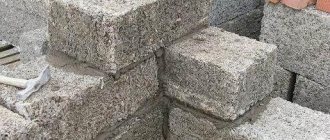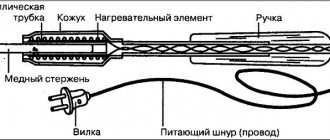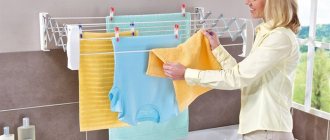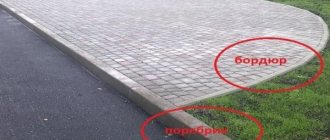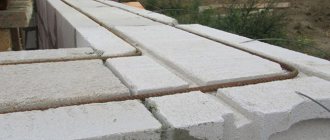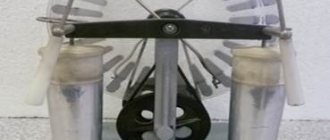What is aerated concrete and what are its characteristics
Before using aerated concrete for the construction of houses and other buildings on the site, it is recommended to first determine its characteristics.
Basic properties and qualities
In accordance with international quality standards and GOST, the material must have a list of certain qualities. High-quality material should withstand 35-100 cycles of freezing and defrosting. The thermal conductivity index of aerated concrete is 0.09-0.38. The density of the material is D300-D1200. The average vapor permeability is 0.2. The shrinkage of aerated concrete is 0.3 millimeters per square meter.
Types of material and products made from it
According to the characteristics of aerated concrete, it is divided into: heat-insulating, structural, structural-thermal-insulating.
Thermal insulating aerated concrete has a density of 300 to 400. It has low thermal conductivity and is characterized by low weight. The use of the material is recommended for thermal insulation of premises.
Structural aerated concrete has excellent strength characteristics and has a density from 1000 to 1200. Thanks to its high thermal conductivity coefficient, it can be used as insulation.
The most popular is structural and thermal insulating aerated concrete. It is characterized by a density of 400-900. With its use, walls and partitions are erected.
Strengths of buildings built from aerated concrete
The material is widely used in construction due to the presence of a large number of advantages:
- To produce the material, sand, lime, cement, aluminum powder and water are used, which ensures the environmental friendliness of the material.
- Aerated concrete is lightweight, which simplifies the process of laying it.
- Thanks to the large size of aerated concrete blocks, the process of constructing aerated concrete is accelerated.
- The material is characterized by a high level of fire resistance.
- Aerated concrete is frost-resistant, which allows it to be used in harsh climatic conditions.
- Thanks to the universal composition of the material, it can be sawed and sanded.
- Aerated concrete allows the use of a variety of materials for finishing buildings inside and outside.
- Indicators such as strength and thermal conductivity are optimal.
- The material is produced by various companies, which allows the client to choose the most suitable option for himself.
- The material has vapor-permeable properties, which allows for an optimal indoor microclimate.
- Aerated concrete has good soundproofing properties, which ensures a comfortable stay in the room.
An aerated concrete house has high performance characteristics, which is explained by the large number of advantages of the material.
Disadvantages of products and their elimination
Before making aerated concrete at home, it is recommended to identify its shortcomings. The material is hygroscopic, which leads to increased water absorption. At negative temperatures, the moisture accumulated in the blocks crystallizes, which leads to their destruction.
In order to solve this problem, walls made of aerated concrete blocks need to be lined. For this purpose, brick, metal profiles, wood and other finishing materials are used.
Manufacturing technology
Despite the name, the technology for producing aerated concrete is quite simple and consists of several parts.
Main part of technologies
A characteristic feature of representatives of this group of concretes is their cellular structure. Gas bubbles occupy up to 85% of their volume, so all cellular concretes have a fairly low volumetric weight.
All source materials for aerated concrete (water, lime, cement and quartz sand) are stirred in an aerated concrete mixer for 4-5 minutes, the mixture is prepared, then a small amount of aqueous suspension of aluminum powder is added to it, which reacts with lime. The reaction product is hydrogen, which forms in the raw material a huge number of pores (bubbles) ranging in size from 0.5 to 2 mm, which evenly penetrate the entire material.
Immediately after adding this aluminum paste, the mixture is poured into special metal containers (see installation above), in which the swelling itself takes place. To accelerate these chemical reactions, as well as setting and hardening, the semi-finished product is subjected to vibration loads. After the aerated concrete reaches the pre-hardening stage, irregularities are cut off from the top of the frozen mixture with wire strings, and the remaining mass is taken and cut into blocks of equal size. The resulting aerated concrete blocks undergo heat treatment in an autoclave (see below). Then the resulting blocks are calibrated using a special milling machine.
Autoclave processing of aerated concrete
Autoclaving the material is an important step that improves the properties of aerated concrete blocks. Already formed and cut into blocks, aerated concrete is placed in special autoclave chambers, in which they are treated with saturated water steam at a temperature of 190°C for 12 hours under conditions of high pressure (12 kg/cm²).
Autoclaved aerated concrete is more durable, has significantly less shrinkage, has a more uniform structure, and can also be used in various fields of construction as the main building, sound-proofing and heat-insulating material. The thermal conductivity coefficient of autoclaved aerated concrete is 0.09-0.18 W/(m °C). Thanks to this thermal conductivity of aerated concrete products, in Russian climatic conditions it is possible (with the exception of the northern regions) to erect single-row walls with a thickness of 375-400 mm, which do not require additional insulation.
Aerated concrete can also be produced using a non-autoclave method. In this case, hardening occurs under natural conditions. Such production will no longer require modern high-tech equipment, so it can even be produced with your own hands at home, but it will be less durable. The shrinkage of non-autoclaved aerated concrete blocks during operation is 3-5 mm/m, while autoclaved ones are 0.3-0.5 mm/m. The strength of autoclave is 28-40 kgf/m², non-autoclave is 10-12 kgf/m².
Conventional aerated concrete is produced much less frequently than autoclave concrete, but again it can be made at home, because no sophisticated equipment is required for this.
Do-it-yourself gas block production
The technology for producing aerated concrete at home requires the master to adhere to certain rules. This process consists of several stages.
Required set of equipment and materials
Before making aerated concrete, you need to prepare materials and tools. Concrete is made from a mixture of the following materials:
- Sand. It is recommended to give preference to quartz sand, which has previously undergone a washing and drying process.
- Cement. High-strength material is obtained by using cement, which has a grade of more than 400.
- Clean water.
- Quicklime.
- Aluminum powder, caustic soda, sodium sulfate.
Forms
Before making aerated concrete, molds are prepared. You can buy ready-made products in construction stores. To save money, they are created independently. Initially, the pencil case is made from wooden boards. Jumpers are inserted into it, with the help of which the frame is divided into compartments. The molds can be made from moisture-proof plywood. In order to fix the boards, you first need to make cuts in them.
The dimensions of the cells must match the dimensions that, in accordance with the project, the finished block should have. In order to speed up the production process, it is recommended to construct several molds simultaneously. In order to prevent the solution from sticking to the molds, they must first be lubricated with a special product. At home, it is recommended to use used machine oil, which is diluted with water in a ratio of 1:3.
In order to speed up the production of aerated concrete, you can use mobile installations, which consist of a compressor, mixer and connecting hoses. Devices are pre-prepared to remove excess concrete.
Preparation of the solution
The process of making aerated concrete at home begins with preparing the solution. The number of components used depends on the density of the material the user wants to obtain. Consider the option of preparing a solution for aerated concrete with a density of 1600 kilograms per cubic meter. For this you will need 1100 kilograms of sand and 400 kilograms of cement. The components are thoroughly mixed. To them you need to add 5 kg of lime. Additives such as caustic soda, aluminum powder and sodium sulfate are also added to the solution.
After thoroughly mixing all the dry ingredients, they are filled with 189 liters of water. After mixing the composition until smooth, it can be used for pouring.
Fill
After lubricating the molds with a special composition, the solution is poured into them. In this case, you need to make sure that the molds are not filled to the brim, since when it hardens, the mixture swells and the excess will lick out. The molds need to be filled halfway. After pouring the material, gas formation occurs. At the next stage, excess mixture is removed using metal strings. The procedure is carried out 5-6 hours after pouring.
18 hours after pouring, the products can be stripped. In order for the aerated concrete blocks to move better, you need to knock a little on the forms. After a month, aerated concrete will gain technical strength. Hardening of blocks is observed not only indoors, but also in open areas.
Comparison of self-produced and factory-produced products
When producing aerated concrete blocks with your own hands, they are hardened by hydration, and in production - by autoclave. These materials differ from each other in technical and physical parameters. In production, blocks are manufactured using stationary and conveyor methods. When using the second option, the need for human participation is reduced to a minimum. In the home production of material, a person takes a constant and direct part.
Compared to autoclaved aerated concrete, home blocks are less durable. Also, the factory material has the best indicators of frost resistance, fragility, and thermal conductivity.
Do-it-yourself one-story aerated concrete house. Tool
For uniform placement of glue there are branded carriages. They are a box into which up to a bucket of solution is loaded. Do-it-yourself laying of aerated concrete blocks using a carriage is shown in the following
Carrying it up and down the walls is a dubious pleasure and is justified only for large volumes, when the entire bucket can be rolled along the wall at one time. Therefore, when independently building an aerated concrete house, simpler devices are often used - small manual carriages (look at the photo). As you can see, it looks like a scoop and is easy to make with your own hands from a piece of galvanized steel. The width is equal to the width of your block (exactly up to a millimeter, maybe 1-2 mm less). Teeth are cut along the edge (you can use a grinder), and a handle is attached. In principle, you can get by with a trowel and a large notched trowel, but the work will not be as convenient.
The second necessary tool is a saw. There is also a special one, but foam concrete can be cut perfectly with an ordinary handsaw with a well-sharpened tooth.
Carriage and saw - basic tools
You also need a piling device. According to the construction technology of aerated concrete, reinforcement is laid in every 4th row. For these rods, grooves are made in the body of the block. There is a special tool for this - a cutting edge on a handle with a rest for the second hand. You can also do something similar yourself.
Two models of wall chaser for gas block
Devices for transferring blocks are also needed. There are blocks with cutouts for arms, but they are more expensive, and the voids will then have to be filled with mortar. To transfer blocks with smooth edges, there are special pliers that work due to gravity.
Block transfer device
In addition to all this, you need a container for mixing glue, a paint ladle, a mallet to level the blocks, a brush to clean off dust, a building level, a cord, a set of sandpapers or a special grater to level the surfaces. That's all the necessary tool. There is another interesting device - an angle that allows you to cut at right angles. In the photo it is near the helmet, but you can do without it if you wish.
Profitability of production
The profitability of block production is influenced by various factors. It depends on:
- Cost of raw materials;
- Investments for the purchase of equipment;
- Amounts of production waste;
- Desired volume;
- Production goals.
Experts carried out calculations in accordance with indicators, according to which it was found that making aerated concrete blocks with your own hands is more expensive than purchasing ready-made material. In addition, this process requires effort and time.
Aerated concrete blocks are a universal building material that is widely used for the construction of buildings. You can purchase it at factories and construction stores. You can also make the blocks yourself, having previously calculated the profitability of this process.
